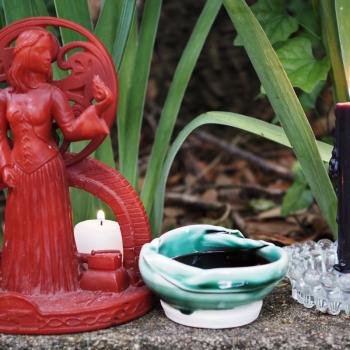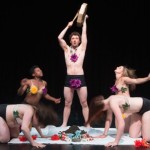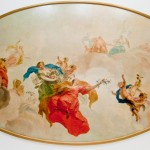I attended many rituals over over the 3 day Pantheacon event. I want to talk about each of them briefly and then talk a little about what it is like to attend so many rituals in such a short period.
Day 1: Friday (starting the in the afternoon)
Opening Ritual by Glenn Turner
The first ritual was what I would call a generic Pagan ritual. There was zero preparation — a fact which Glenn just laughed off, but pisses me off. Spontaneity can be a virtue, but too often its just a cover for lack of effort. Glenn spent more time getting people to volunteer to call the quarters and invoke the God and Goddess than the actual ritual itself took. From a Pagan perspective, it was unremarkable. It was the worst of everything about generic Pagan rituals which I have written about before. There was no poetry, no enchantment. Even the name of the ritual reflected its blandness — “Opening Ritual”.
“The Dance of Diversity” by Reclaiming
This ritual was a community building experience — not surprising as it was conducted by Reclaiming. We all stood in a circle and then were led in a kind of walking meditation that ended with us making deliberate and prolonged eye contact with the others there. For an introvert like myself, this was difficult, but also rewarding. I don’t recall any invocation of deity, although there may have been. The real focus was on connecting with the others there and experiencing their difference. (Viva la difference!) I felt it was a successful ritual. I identify deity with the “other” found in self, nature, and other people. So connecting with other people in this way was an experience of divinity — Namaste!
“Welcoming the Sabbath Bride” by “a couple of Jews” (that’s how they identified themselves)
Having never been to a Jewish ritual, this was interesting. I enjoyed all the singing, some of which was call and response. And I appreciated that they had printouts of the text, so we could follow along. However, the ritual leader elected to do most of the ritual in Hebrew. Although there was an English translation next to the Hebrew text, I had a difficult time following along. You may be wondering what made the ritual Pagan — I was too. The text was taken from the prayer book of a liberal synagogue and had gender inclusive language. The Sabbath Bride was mentioned, but there was little to nothing I could identify as Pagan per se. A lot of the people in attendance were Jewish or formerly Jewish, so they knew many of the songs by heart. I didn’t know the tunes or the Hebrew, so I had a hard time getting into it. The challah bread was good though. Shalom aleichem!
“Pomba Gira Devotional” by American Magic Umbanda House
Pomba Gira is a female Umbanda deity associated with sexuality and desire. This “devotional” is an annual event at Pantheacon and it is really more of a dance party than a ritual. Most everyone was dressed in sexy red and black. The atmosphere was sexually charged and the music was good. (“Pomba knows what you desire.”) It was fun. But it was more like the “Pan’s Ball” at Pagan Spirit Gathering. It felt more like a mundane expression of sexuality than a sacred experience.
That was four rituals in the first afternoon and evening of the Con, in addition to non-ritual workshops.
Day 2: Saturday
Church of All Worlds Watersharing
I had an open block on Saturday morning, so I decided to visit the CAW hospitality suite. The ritual got started at least a half hour late (of course), but I’m glad I stayed. The CAW watersharing ritual is short and very simple. The ritual leader spoke about the symbolism of water and how it connects us, and then we each passed a chalice around taking sips. When we passed the chalice, we said “May You Never Thirst” and/or “Thou Art God/dess”. If we were sick (like I was), we just passed it on without partaking. The ritual is a simple expression of our connection to the physical world and to each other. I think it was great. Thou art God/dess!
“Exorcism: A Rite of De-Possession and Re-Integration” by T. Thorn Coyle and others
This was a very well planned and well executed psychological-type ritual. We were led into a darkened room and gathered in a circle. It was led by five priestesses: Anaar, Morpheus, Sharon, Thorn, and Winter (all trained Feri priestesses). It was obvious who was in charge, though — Thorn has a very type-A personality. The quarters were acknowledged, but not in a traditional fashion, which was nice. The participants were then invited into the circle to purge themselves of a series of negative attributes: shame, fear, obsession, rage, and greed. (I notice the group seemed a little ambivalent about “purging” obsession.) There was drumming, strong rhythmic breathing, and very expressive ritual gestures. It was an effective cathartic ritual (for me at least), but I’m not sure about the “re-integration” promised in the title. I chose to enter the circle during the “fear” portion of the ritual. Just the act of joining the ritual in this way was an act in defiance of numerous fears I have. But I specifically had in mind the general fear I have of being jobless. I breathed and pounded and thrust and screamed my fear out with the best of them. At then end, I truly did feel fearless. Still, I wonder if those feelings of fear do not have to be ritually reintegrated somehow. Perhaps sometimes catharsis is enough.
“Danbala Sevis — Honoring the Serpent and the Rainbow” by Mambo Tann
The was billed as a Haitian Vodou ritual. Those who were not wearing all white could observe, but not participate. That was fine because it was in the ritual description in the program. What the program did not tell us is that we should not wear black, even to observe. Since I was wearing black, I had to sit as far from the ritual as the room permitted. Mambo Tann assumed a lot of her audience. When it was all said and done, I still did not have any idea of who Danbala was. Mambo Tann had brought her own ritual group and another ritual group to assist. Almost all of them were Caucasian. There were no drums, the singing was uninspired, and there was no ecstatic dancing. The ritual was done in mumbled Haitian French. Although the text was projected onto a screen, there was no translation. It was very repetitive (lots of walking back and forth to the quarters) and not at all interesting to watch. At the climax, Mambo was briefly possessed by Danbala. Because I was so far away, it was hard to see what was going on, but it looked like she was rolling around on the ground a bit and making strange noises. When she came back to herself, she was exhausted and dehydrated. The group then gathered around to interpret the deity’s actions. I had the impression that the “spirit” was like a big baby — demanding and immature. I left wondering why they would want to invoke him.
So that was 3 more rituals on the second day.
Day 3: Sunday
“Offerings to Isis: Sharing with the Dead” by Tamara Siuda
This was a Kemetic (Egyptian Reconstructionist) ritual. I was surprised to learn that Tamara Siuda and Mambo Tann were the same person. The Kemetic ritual had very much the same feel as the Haitian Vodou ritual from the night before — minus the possession. It was not as long, but it was no more inspired. The text was largely in Egyptian, and there was no translation. Offerings were made to Osiris and Isis. And then we spoke the names of our honored dead. At the end, we were invited to write their names on an oversized pad of paper on an easel. We sat and watch as one person after another wrote the name of every ancestor they could recall. This went on and on until near the end someone realized they had a second marker and we could have gotten through this portion twice as fast. I remember a workshop I went to at PSG where Steven Posch talked about how lines are the death of any ritual. In addition to the line, the other problem with this ritual is that we were spectators for the most part. Tamara and her associates were the priests and we were the congregation. That probably had something to do with ritual purity, but it was pretty foreign to the democratic and participatory nature of most Neopagan rituals. (Of course, Tamara does not consider herself Pagan, as I discussed in the last post.)
“Feraferia: A Dance for the Goddess” by Jo Carson
This was by far my favorite ritual. It was truly a multisensory experience and it was well planned and well executed. It was a seasonal celebratory ritual honoring the god and goddess of the sea, which Feraferia dedicates its Imbolc ritual to. There was incredible music being played by Matt Venuti on the Hang (which you should really check out). There was an interpretive dancer dancing to the music. They made good use of what lighting effects were available. We were offered water from a chalice and berries as a kind of communion. We were anointed with scented oil and aspersed with water. There were statues of the god and the goddess to which we offered candles. There were poles with colored pennants and Fred Adams’ artwork. And there was poetry. They kept us moving. We held hands and danced in a circle. I can only imagine how great it must have been if performed outside (as I believe it usually is). Evoe Kore!
“Body Stress Ecstatic Practices” by Kirk Thomas
This was easily the most intense experience I had at Pantheacon. Thomas began with a general introduction to ecstatic practices generally, and then introduced us to the history of “body stress” practices, including the Plains Indian Sun Dance and the modern primitive movement. Then Thomas demonstrated a “hook pull” on someone who had never had it done before. It was intense! Essentially, he placed hooks under the skin of the young man’s back and tied them to ropes from which the young man hung, by leaning forward and letting his body weight suspend him. Yes, he did it right there! We all clapped in rhythm or improvised drums, which heighten the tension. Thomas then invited all of us to come up and place our hands on the young man in turn. The next to last person to do this was a young woman who stood in front of young man and looked him in the eyes and touched him in such a way that … well, she really eroticized the moment. While leaving the young man hanging, Thomas then had an experienced volunteer lay down and fixed pins in her. Each pin represented something that each one of us who were watching wanted to release — so in a sense we were responsible for one pin. There was not a lot of formality of this demonstration, and Thomas was pretty clinical about the execution (for health and safety reasons), but I still experienced it as a ritual event.
Kali Puja: Mysteries of the Dark Goddess” by Chandra Alexandre and Sharanya, a devi mandir (Shakta Trantra goddess temple)
By this point, I was over-sensitized. I had just left the body-stress demonstration, and so I had a hard time shifting gears. The Kali Puja was an ecstatic devotional ritual to Kali Ma. I eventually withdrew myself from it and just observed so I could try to sort out what was going on internally. The ritual was beautiful, there was drumming and music. I think Chandra assumed a little too much of us though. It was a devotional ritual and I kept wondering who it was we were supposed to be expressing devotion to. I have a better idea now that I have looked up their website. I think some of the other participants must also have been confused. At one point we were all asked to speak aloud something we were grateful to the goddess Kali for. Many people spoke about challenges in their lives, which seemed appropriate. But others spoke of their family, their health, their home — blessings that I at least do not associate with Kali. Kali is a bitch, as far as I know of her. Not that she is not due her honor in her time and place — Jai Maa! — but I would not thank her for my home or my health. Also, a lot of the text was in untranslated Sanskrit. I suppose that gives a sense of authenticity to the experience, but I’m too much of a rationalist not to want to know what it is I am saying. I have since found out since the liturgy is posted on their website.
This was 4 more rituals on the third day. I was really beginning to wonder about the wisdom of ritual hopping at this point.
Day 4: Monday Morning
“In the Temple of the Mysteries: A Ritual of Communion” by Mysterium OM
This was the last ritual I attended at the Con. It was conducted by an esoteric group which I learned afterward is more Christian than they let on at the Con. Diana Young and her husband, Robert Young, led the ritual. Diana started with a half hour read lecture on “the higher mysteries”, which she contrasted with “earth-based” religions. She explained the importance of “the Word” in the mysteries. And boy, she wasn’t kidding. This was easily the wordiest ritual of the entire Con. To a certain extent, I appreciated the preparatory exposition — a lot of the other rituals I attended could have benefited for just a little explanation. But a half of an hour of being read to is a bit much in a 90 minute ritual. And then the ritual itself was extremely wordy. Robert stood in the center of the circle and there were four assistants at each of the quarters. They were all wearing plain white robes. Robert addressed the quarters four different times I think. Although he said something different each time, it all sounded the same to me. The basic idea is that we are spirit become flesh. That was it. But it went on and on and on. Then we partook of a communion wafer/cookie. In spite of the communion, the overall impression I had was that we need to realize our spiritual natures. As someone seeking an embodied spirituality, this really was counterproductive for me. I later overheard someone talking about what an amazing ritual it was. But it did nothing for me. I’m glad I went, because I wanted to have the experience of an esoteric-type ritual. It ended up confirming what I already thought about groups that tend to capitalize the “M” in the word “mysteries”.
This was the last ritual I participated in at the Con. I skipped the closing ritual, since I did not expect anything more than I experienced at the opening ritual. After 12 rituals in 36 hours, I was exhausted. And that was in addition to the non-ritual workshops I attended. Near the end, I really started to think about how curious it was to jump from one ritual to another over the course of a day. I really should have given myself some more time between these events to “ground and center”. Even then I would not recommend doing more than two rituals a day, one in the morning and one in the evening.
I went to the Con with the intent of exposing myself to many different traditions and different ritual experiences. I succeeded in that regard. But I just was not able to fully immerse myself in the experience every time. I found the seasonal celebratory Feraferia ritual the most satisfying. It engaged all five senses (without using incense) and the choreography was near perfect. (There is an art to moving people around without any prior instruction.) I think the Kali Puja was well done also, but I would have enjoyed it more if I had done my homework first, or if there had been a little more explanation beforehand.















